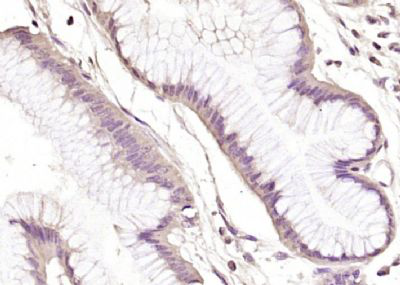产品货号 : mlR7961
英文名称 : ANKRD11
中文名称 : 锚蛋白重复结构域蛋白11抗体
别 名 : ANCO 1; ANCO1; Ankyrin repeat containing cofactor 1; Ankyrin repeat domain 11; Ankyrin repeat domain containing protein 11; LZ16; T13; ANR11_HUMAN; Ankyrin repeat domain-containing protein 11; Ankyrin repeat-containing cofactor 1.
研究领域 : 肿瘤 细胞生物 肿瘤细胞生物标志物
抗体来源 : Rabbit
克隆类型 : Polyclonal
交叉反应 : Human, Mouse, Rat, Dog, Cow, Horse,
产品应用 : WB=1:500-2000 ELISA=1:500-1000 IHC-P=1:400-800 IHC-F=1:400-800 IF=1:100-500 (石蜡切片需做抗原修复)
not yet tested in other applications.
optimal dilutions/concentrations should be determined by the end user.
分 子 量 : 296kDa
细胞定位 : 细胞核
性 状 : Lyophilized or Liquid
浓 度 : 1mg/ml
免 疫 原 : KLH conjugated synthetic peptide derived from human ANKRD11:731-820/3663
亚 型 : IgG
纯化方法 : affinity purified by Protein A
储 存 液 : 0.01M TBS(pH7.4) with 1% BSA, 0.03% Proclin300 and 50% Glycerol.
保存条件 : Store at -20 °C for one year. Avoid repeated freeze/thaw cycles. The lyophilized antibody is stable at room temperature for at least one month and for greater than a year when kept at -20°C. When reconstituted in sterile pH 7.4 0.01M PBS or diluent of antibody the antibody is stable for at least two weeks at 2-4 °C.
PubMed : PubMed
产品介绍 : Ankyrin is a membrane protein that mediates the attachment of the erythrocyte membrane skeleton to the plasma membrane and interacts with CD44 and inositol triphosphate. It contains three functional domains: a conserved N-terminal ankyrin repeat domain (ARD(consisting of 22–24 tandem repeats of 33 amino acids), a spectrin binding domain and a variably sized C-terminal regulatory domain. The ankyrin repeat is a 33-residue motif in proteins consisting of two alpha helices separated by loops. It has been studied using multiple sequence alignment to determine which conserved amino acid residues are critical for folding and stability. Ankyrin-repeat proteins have been associated with a number of human diseases; most notably, the cell cycle inhibitor p16 is associated with cancer and the Notch protein is a key component of cell signaling pathways whose intracellular repeat domain is disrupted in mutations that give rise to the neurological disorder known as CADASIL.
Function:
May recruit HDACs to the p160 coactivators/nuclear receptor complex to inhibit ligand-dependent transactivation.
Subunit:
Interacts with the PAS region of the p160 coactivators.
Subcellular Location:
Nucleus.
DISEASE:
Defects in ANKRD11 are the cause of KBG syndrome (KBGS) [MIM:148050]. A syndrome characterized by macrodontia of the upper central incisors, distinctive craniofacial findings, short stature, skeletal anomalies, and neurologic involvement that includes global developmental delay, seizures, and intellectual disability.
Similarity:
Contains 4 ANK repeats.
SWISS:
Q6UB99
Gene ID:
29123
Important Note:
This product as supplied is intended for research use only, not for use in human, therapeutic or diagnostic applications.
产品图片












